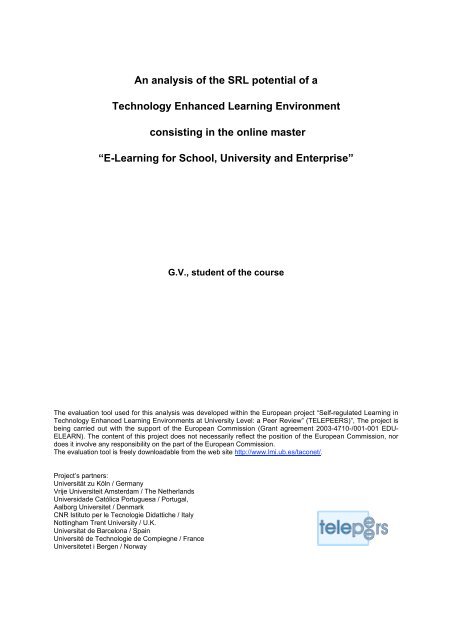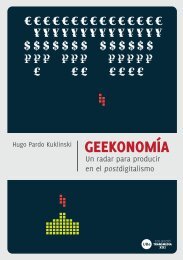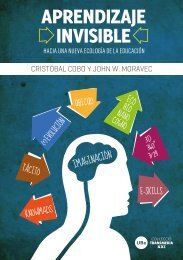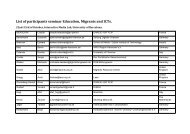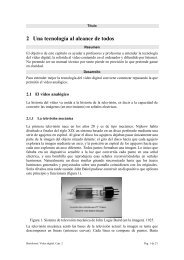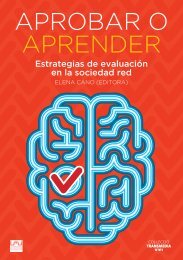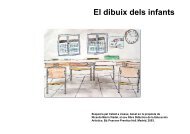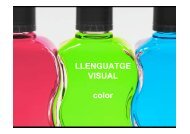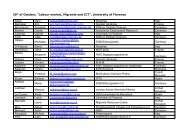download - LMI - Universitat de Barcelona
download - LMI - Universitat de Barcelona
download - LMI - Universitat de Barcelona
- No tags were found...
You also want an ePaper? Increase the reach of your titles
YUMPU automatically turns print PDFs into web optimized ePapers that Google loves.
An analysis of the SRL potential of aTechnology Enhanced Learning Environmentconsisting in the online master“E-Learning for School, University and Enterprise”G.V., stu<strong>de</strong>nt of the courseThe evaluation tool used for this analysis was <strong>de</strong>veloped within the European project “Self-regulated Learning inTechnology Enhanced Learning Environments at University Level: a Peer Review” (TELEPEERS)”, The project isbeing carried out with the support of the European Commission (Grant agreement 2003-4710-/001-001 EDU-ELEARN). The content of this project does not necessarily reflect the position of the European Commission, nordoes it involve any responsibility on the part of the European Commission.The evaluation tool is freely <strong>download</strong>able from the web site http://www.lmi.ub.es/taconet/.Project’s partners:Universität zu Köln / GermanyVrije Universiteit Amsterdam / The NetherlandsUniversida<strong>de</strong> Católica Portuguesa / Portugal,Aalborg Universitet / DenmarkCNR Istituto per le Tecnologie Didattiche / ItalyNottingham Trent University / U.K.<strong>Universitat</strong> <strong>de</strong> <strong>Barcelona</strong> / SpainUniversité <strong>de</strong> Technologie <strong>de</strong> Compiegne / FranceUniversitetet i Bergen / Norway
IntroductionThe concept of Self Regulated Learning refers to a set of abilities and competencies fororganizing and managing the learning process. The existing literature on the topic points out theimportance of some basic variables for <strong>de</strong>veloping SRL, such as awareness and control of theelements involved in the learning process. Moreover, context, motivational elements and emotionsseem to be crucial.The analysis of the relation between ICT and SRL is an interesting field of research,consi<strong>de</strong>ring also that ICT requires some <strong>de</strong>gree of self-regulation.The project TELEPEERS, aiming to analyse the support to SRL provi<strong>de</strong>d by TELEs -Technology Enhanced Learning Environments – gives us useful suggestions and tools forevaluation. A TELE is <strong>de</strong>fined as every learning environment supported by the use of ICT, such asan educational software tool, a multimedia program, a whole course.The present document is an analysis of a TELE consisting in an online master forgraduated stu<strong>de</strong>nts run by University of Genoa, carried out by applying the Telestu<strong>de</strong>nts-SRL, anevaluation tool <strong>de</strong>veloped within the TELEPEERS project.The Telestu<strong>de</strong>nts-SRL is an evaluation tool for TELE, <strong>de</strong>veloped for being filled in bystu<strong>de</strong>nts using the TELE for their learning. This tool is freely <strong>download</strong>able from the web sitehttp://www.lmi.ub.es/telepeers.The consi<strong>de</strong>red TELE is a master for graduated stu<strong>de</strong>nts titled “’E-Learning in school,University and Industry" 1 . The course has been organized and run by the Learning ScienceDepartment of the University of Genoa, the Educational Technology Institute of CNR (Genoa) andby the Italian Association for Artificial Intelligence. The master has been <strong>de</strong>veloped almostcompletely online (there were only three face-to-face meetings within the course) and its totallength was 800 hours (including 180 hours for internship activity).The platform used was EifFE-L (Environment for Freedom in E-Learning – see figure 1 -)<strong>de</strong>veloped in CampusOne-CRUI. It is an e-learning environment consistent with the ADL-SCORMmo<strong>de</strong>l and with the current availability policies. It is an open source platform published - withGeneral Public License - on the site SourceForge.net.1 The web site of the course is: http://masterelearning.unige.it/2
Figure 1 The home-page of the online courseObjectives of the course were the acquisition of scientific, technological, methodologicaland cultural competencies for the construction and management of online learning tools an<strong>de</strong>nvironments. The various subjects and topics addressed during the course can be subdivi<strong>de</strong>d intofive macro-areas: 1) projecting e-learning activities 2) constructing and <strong>de</strong>livering learning material3) groups management 4) assessment 5) cross-curricular subjects (English language, law for thenet, economics for the web).Several educational activities were proposed by the teachers: both individual groupactivities of study and research, construction of learning objects, simulations, production of papers,practical stages. Several application programs were used to carry out these activities: software foroffice automation, graphical editors, html editors, communication platforms. All activities werecarried out trying to exploit the potential of communication and collaboration among theparticipants, following a constructivist educational methodology.All interaction among all subjects were carried out mostrly through the the tools put atdisposal by the (in-house built) communication environment: forums, chat, posting board, mailbox;sometimes, these were integrated by direct communications, telephon calls or private mail.The tutors played a fundamental role. They always helped the teachers in their educationalactivity, facilitated learning and kept alive the interaction with the stu<strong>de</strong>nts.The master was followed by ten stu<strong>de</strong>nts, all adults with a varied socio-cultural background.In analysing this master with the telestu<strong>de</strong>nts-SRL, the point of view adopted was my own,that is that of a stu<strong>de</strong>nt who has followed the master and looks at it as a complex environmentwhere different fundamental elements take part: the educational strategy, teachers and tutors, theknowledge learned, the educational activities, ICT. Because of the articulation of the environment,3
the analysis with the questionnaire has not been easy. I inserted some comments in sections c)and d) in or<strong>de</strong>r to clarify my answer to the questions.4
PART A: Description of TELETo be filled in by the teacher/coach.The <strong>de</strong>scription of the TELE should rather be inserted by the teacher who administers thequestionnaire, in or<strong>de</strong>r to avoid misun<strong>de</strong>rstandings on the extent of the TELE, and to avoidobtaining not homogeneous results.• Please <strong>de</strong>scribe the learning environment which you are evaluating. The learningenvironment might be a face-to-face course (with a tutor, computers and Internetaccess) or just a CD with which you worked on your own.• Describe the subject, study year, and the purpose of the course.• Describe the type of learning activities that stu<strong>de</strong>nts un<strong>de</strong>rtake and whether they workon their own or with peers (or both).• Describe the role of the tutor in the course.• Finally, shortly <strong>de</strong>scribe the computer programs and/or Internet applications that wereused.Learning environment:First level University Master “E-learning for the school, the university and the enterprise”.Distance course with three presence meetings, organized by the Faculty of Educationalsciences of Genova University, the ITD CNR and the Italian Association for ArtificialIntelligence.Subject, study year and purpose of the course:Object of study was ICT-supported distance education.Time: January-November 2005.The master aims to prepapre educational technologists competent in <strong>de</strong>signing andmanage web-based distance courses.Type of learning activities:The master promoted:• Individual and group activities in presence• Study and research activities at a distance• Stages at some enterprise and preparation of a final paper.The role of the tutor:The tutors helped the teachers in keeping alway open the virtual classes. They conductedpart of the didactical activities, facilitated learning and supported the stu<strong>de</strong>nts in difficultpoints.Computer programs and/or Internet applications:The master was conducted almost completely on the portal EifFE-L (Environment forFreedom in E-Learning) <strong>de</strong>veloped within the CampusOne-CRUI project. .Several software tools were used during the activities: Skype, NetMeeting, MS Word, MSExcel, MS Access, Macromedia Dreamweaver, Macromedia Flash, MacromediaFireworks.5
Part B: Personal informationPlease fill in or check where appropriate.• Country of resi<strong>de</strong>nce: Italy• Name of university or institution: Istituto Tecnologie Didattiche – CNR - Genova• Subject of study: E-Learning• Age: 29 years• Sex: O female O male• Present status:O high school stu<strong>de</strong>ntO vocational training stu<strong>de</strong>ntO un<strong>de</strong>rgraduate stu<strong>de</strong>ntO graduate stu<strong>de</strong>ntO doctoral stu<strong>de</strong>ntO teacher or trainee teacherO other (please explain) __________________• It is the first time that I have been working in this kind of learning environment.O yesO no• How long have you been working in this environment? 10 months6
Part C:Evaluation of self-regulation aspects of the TELEI found the possibility to personalize the user interface of the TELE usefulDisagree 0 1 2 3 4 5 agreeThe platform does not allow the stu<strong>de</strong>nts to personalize the interface. Not applicable.I found the possibility to structure the learning contents usefulDisagree 0 1 2 3 4 5 agreeThe platform does not allow the stu<strong>de</strong>nts to structure the learning contents. Not applicableI found the possibility to choose amongst available contents (e.g. skip a section, choose amongdifferent options) usefulDisagree 0 1 2 3 4 5 agreeThere is a wi<strong>de</strong> choice of different learning contents and it is easy, and allowed, to chose amongthem.I found the possibility to choose from different levels of difficulty in the TELE useful.Disagree 0 1 2 3 4 5 agreeThere is no differentiation among difficulty levels. Not applicable.I found the possibility to select between different presentations of the same content materialsusefulDisagree 0 1 2 3 4 5 agreeThis possibility was given very rarely, hence Not applicable.The TELE allowed me to establish personalised learning goals.Disagree 0 1 2 3 4 5 agreeGood possibility to establish personal objectivesThe TELE helped me to plan my learning activities.Disagree 0 1 2 3 4 5 agreeThis support given by tutors and teachersThe TELE allowed me to switch to a new learning strategy if necessary(i.e. a way of planning the actions to carry out in or<strong>de</strong>r to learn).Disagree 0 1 2 3 4 5 agreeThe TELE resulted rather flexible from this point of viewThe TELE encouraged me to actively participate in learning or problem solvingDisagree 0 1 2 3 4 5 agreeTutors and teachers always encouraged stu<strong>de</strong>nts’ participationThe TELE helped me to reflect on my own problem solving activities.Disagree 0 1 2 3 4 5 agreeMostly relying on individual initiative of some teachers, this kind of support was in my opinioninsufficientThe TELE helped me to reflect on my learning progress.Disagree 0 1 2 3 4 5 agreeNot enough support in this sense7
The TELE helped me to find out to what extent I am achieving my learning goals.Disagree 0 1 2 3 4 5 agreeThe TELE provi<strong>de</strong>d me with appropriate feedback on my work and achievements.Disagree 0 1 2 3 4 5 agreeSuch feedback were not enoughThe TELE gave me feedback reminding me of knowledge and skills relevant to solve tasksDisagree 0 1 2 3 4 5 agreeThe TELE suggested to me how problems might be solved.Disagree 0 1 2 3 4 5 agreeThough with some exceptions, this support was not enoughThe TELE helped me to increase my confi<strong>de</strong>nce in my own abilities.Disagree 0 1 2 3 4 5 agreeOverall, the TELE positively contributed to <strong>de</strong>velop more awareness of my abilities andpossibilitiesThe TELE helped me to keep up a positive working attitu<strong>de</strong>.Disagree 0 1 2 3 4 5 agreeThe TELE did not contribute much to the <strong>de</strong>velopment of such attitu<strong>de</strong>.The TELE helped me to restore a positive working attitu<strong>de</strong> at points where I was experiencingparticular difficulties in the learning processDisagree 0 1 2 3 4 5 agreeThe TELE did not contribute much to the <strong>de</strong>velopment of such attitu<strong>de</strong>.The online help facilities of the TELE encouraged me to continue working after a failure.Disagree 0 1 2 3 4 5 agreeThis was partially missingThe TELE helped me to work out strategies to keep up my motivation.Disagree 0 1 2 3 4 5 agreeI found the possibility to contact and receive help from my tutor/instructor useful.Disagree 0 1 2 3 4 5 agreeCertainly, thanks to the abundance of communication means at disposalI found the possibility to discuss my work with my tutor/instructor usefulDisagree 0 1 2 3 4 5 agreeThe portal structure and the attitu<strong>de</strong> of the human resources involved allowed a continouscomparison with teachers and tutors on the work carried out.I found the possibility to compare my results with that of my tutor/instructor useful.Disagree 0 1 2 3 4 5 agreeI found the possibility to work together with my peers useful.Disagree 0 1 2 3 4 5 agreeI found the possibility to compare my results with those of my peers useful.Disagree 0 1 2 3 4 5 agreeThis possibility was not given much, hence Not applicable.8
I found the possibility to communicate with my peers useful.Disagree 0 1 2 3 4 5 agreeI found the possibility to do self-assessment exercises usefulDisagree 0 1 2 3 4 5 agreeWith rare exception, this item is Not applicable. .I found the possibility to choose which skills to self-assess usefulDisagree 0 1 2 3 4 5 agreeNot applicable.9
PART D:General evaluation of the TELEGlobally, working in this learning environment helped me to organise my learningVery little 0 1 2 3 4 5 Very muchThis aspect could be improved.I have the feeling that working in this learning environment, I achievedVery little 0 1 2 3 4 5 Very muchI feel sufficiently sure to have realized my objectives.The TELE was organised in such a way that I enjoyed working in it.Disagree 0 1 2 3 4 5 agreeAlso this aspects could be improvedI found the TELE to be stimulatingDisagree 0 1 2 3 4 5 agreeFrom this point of view, the TELE was not sufficiently stimulatingWe would also like to know to which extent different aspects of the learning environmentwere important for your learning outcome. If you did well was it because you had a goodtutor or because the software you used was very good ? Or were you successful becauseyou invested a lot of effort or because you simply are a bright stu<strong>de</strong>nt? If you did not dowell, why was that? Who was primarily responsible for your learning outcome in that case?For achieving the goals of the course….my tutor/instructor wasnot important 0 1 2 3 4 5 very importantmy peers weretechnology (computer program,Internet application) wasmy ability wasmy effort wasthe knowledge that I had before wasother aspects (which ones?)werenot important 0 1 2 3 4 5 very importantnot important 0 1 2 3 4 5 very importantnot important 0 1 2 3 4 5 very importantnot important 0 1 2 3 4 5 very importantnot important 0 1 2 3 4 5 very importantnot important 0 1 2 3 4 5 very important10
What are good aspects of this TELE ?The human component was the most positive aspect of this TELE. Part of the goodresults obtained in this master <strong>de</strong>pend on the committment and professionality of thetutors and teachers involved.The platform used for the educational activities was very clear and simple to use; thisis very important in or<strong>de</strong>r to allow those who are not habitual users of ICT to startusing the environemnt weel after a short time.What are weak or negative aspects of this TELE ?Time organization was imperfect. This is emphasized by a dishomogeneousdistribution of the activities over the course. This is negative since it <strong>de</strong>terminednegative attitu<strong>de</strong>s.The portal resulted scarcely flexible and does not allow to personalize the learningpath (this problem was partially solved by the constructive attitute of teachers andpeers)..What suggestions do you have for improving this TELE ?The structure of the course does not need to be radically changed. The master hasalready a good starting basis, but attention to some aspects would be useful:• A ri-organization of the time tables;• Attention to the different committment of the teachers;• A revision of the platform by making it more stimulating and pleasant and byadding some functions.11


